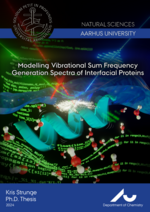Interfaces play a deciding role in many aspects of modern chemistry and material science – catalysis, adhesion, sensing, nucleation are all processes driven by interfaces.
We use methods based on static and time-resolved sum frequency generation to probe the orientation, structure and dynamics of molecules at interfaces. Near-edge X-ray absorption fine structure (NEXAFS) spectroscopy and microscopy are used as complementary tools to probe binding chemistry, surface distribution and molecular structure.
An important part of our research are protein structures at interfaces. Specific proteins can act as Nature’s engineers of both hard and soft tissue. Proteins can ‘sculpture’ biogenic minerals and shape cell membranes. The control interfacial proteins exert over biological surfaces has relevance for disciplines as diverse as cell biology, bio-sensor research, biomimetics and material science. We ask how proteins fold and move at surfaces and how energy flows through protein interfaces.
For technical applications we use chemical modification of surfaces to prevent biofouling and scaling and to reduce friction. The approaches we use are inspired by our studies of the surface chemistry of animals. Can we fabricate self-cleaning surfaces like plants? Stick to walls like a spider? Glue like a frog tongue?
The goal of our research is to understand how molecules operate at surfaces and how we can control interfacial processes at the molecular level.

Monday the 17th of June 2024 at 14.00 in Aud I (1514-213).
Kris Strunge is defending his PhD thesis ”Modelling Vibrational Sum Frequency Generation Spectra of Interfacial Proteins”.

January 2024
SurfLab researchers, together with an international team of collaborators, have published a paper in Journal of Physical Chemistry entitled “Umbrella-Like Helical Structure of Alpha-Synuclein at the Air-Water Interface Observed with Experimental and Theoretical Sum Frequency Generation Spectroscopy”.
In the paper, the researchers derive the structure of α-synuclein at the air-water interface by combining molecular dynamics with surface specific vibrational spectroscopy. Results show that the structure resembles an umbrella, which could help explain the α-synuclein aggregation associated with Parkinson's Disease.